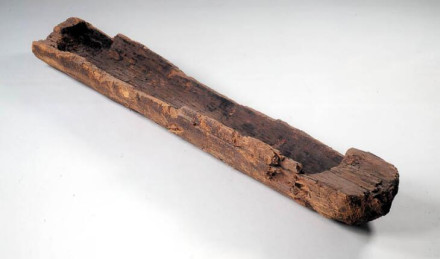Logboats
Logboats (also called dugout canoes and monoxylon) are the archetype of boat types. The logboat is the oldest known vessel type and is found across the world.
Logboats in Europe
Prehistory
The most basic form is a hollowed out tree trunk. The oldest example of this type of logboat is the Pesse canoe (8040 BCE-7510 BCE). This boat, discovered in 1995 near the town of Pesse gives the Netherlands the honor to have the oldest discovered archaeological ship remains in the world.

Logboats were used across the world in prehistory and after that. Examples up to 8000 years old have been found in Europe, Asia, America and Oceania.
Roman period
Logboats were not always (primitive) native forerunners of Roman ships. We see that Roman building techniques and measurements were also used for the logboats. Most of the boats found in Northern Europe have been roughly dated to the Roman period based on surrounding finds. They were used alongside of and together with the big freighters. Logboats can be used for many functions, such as fishing and the transportation of cargo and people.
Built up logboats, Utrecht ship type
The carrying capacity of a boat made from one one log is limited. A way to increase this is to put boards (bulwarks) on them to heighten the sides.
These logboats were often enforced with frames, on the one hand to strengthen the boards (bulwarks) and on the other hand to keep apart the sides that had been artificially pressed outward by burning. This ship type is in between the log boat and the boat fully built out of planks that developed in the middle ages.

This type of logboat is called the Utrecht ship type, after the earliest find of this type of ship in the city of Utrecht in the Netherlands (found in 1930, the Utrecht 1). An expanded logboat like this is the result of a number of elaborations:
a. The hollowed out tree trunk was made extra thin so that it could be bent outward. To get the hull in the desired thickness everywhere, measurement holes were applied. These holes were made in rows and later closed again with small wooden pens. The hollowed out part was reinforced and kept in shape by frames.
The log that was worked in this way could not serve as a separate vessel, it formed the base for the next step in the work.
b. The log base was lengthened with stem boards fore and aft, that gave the boat the shape of a banana seen from the side.
c. Heightening the sides of the log with bulwarks made of one or several planks. These boards (bulwarks) were usually fastened to the log base with wooden pens in a clinker fashion. In this way, a larger volume and amount of carrying capacity was created.
d. The seems were waterproofed with caulking made of moss, closed off with laths that were kept in place with sintels or wooden wedges.
e. In a number of cases, a space was hollowed out in a frame for a mast. It is debated whether the masts were used for sailing or as an aid for towing the boat with a line from the shore. Logboats of this type seem mostly suited as river crafts.
These built up logboats were used alongside boats made out of planks, and in the later middle ages they developed to keel boats made entirely out of planks.